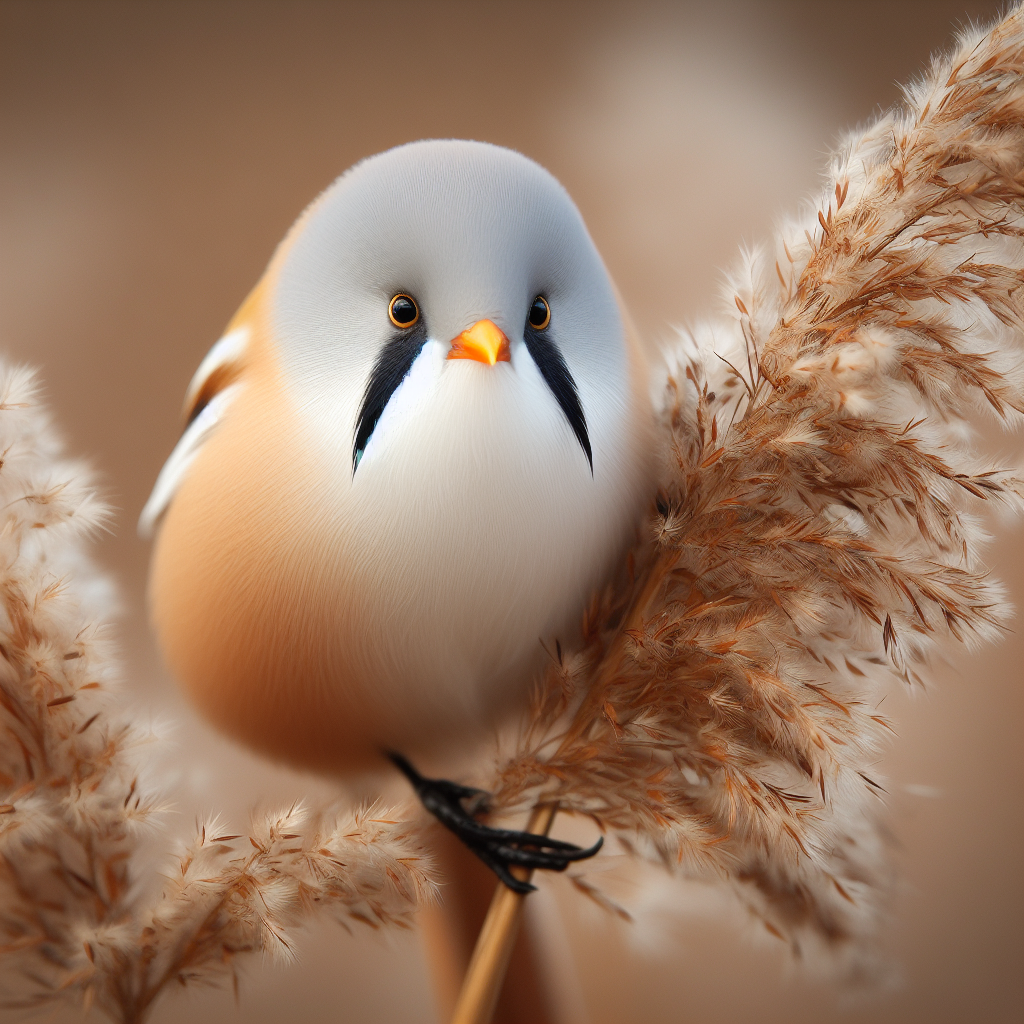Most beautiful small birds - Sykalo Eugen 2024
Bearded Reedling (Panurus biarmicus)
Identification:
- Species name: Bearded Reedling (also known as Bearded Tit)
- Scientific name: Panurus biarmicus
- Family: Panuridae (Bearded Reedlings)
- Order: Passeriformes (Songbirds)
- Subclass: Neornithes (Modern birds)
- Class: Aves (Birds)
Description:
- Size: Small, plump bird, about 16-17 cm (6.3-6.7 in) long with a long tail.
- Body shape: Round and fluffy, with a long, pointed tail and a short, stout bill.
- Plumage color:
Males (breeding season): Pale buff overall with a black mask extending from the bill to the cheeks. Striking black "moustache" stripe extending down from the base of the beak. Rusty-brown wings and tail.
Females and non-breeding males: Duller, with less pronounced black markings and a buffy-brown wash on the upperparts.
- Beak: Short, stout, and conical, pale gray in color, adapted for eating seeds.
- Legs: Short and pale gray.
- Tail: Long and often cocked up when perched.
Behavior:
- Method of feeding: Forages in reedbeds, climbing and clinging to reeds to glean seeds and insects. Also catches insects in mid-air.
- Reproduction: Builds elaborate, woven nests among reeds, often suspended over water. Lays 5-8 eggs. Both parents care for the young.
- Movement: Resident in most of its range, but may move locally in response to food availability or harsh weather.
- Communication: Soft, chattering calls and high-pitched songs. Males sing to defend territory and attract mates.
Ecology:
- Habitat: Dense reedbeds, marshes, and wetlands with tall, thick vegetation.
- Diet: Primarily seeds of reeds and other aquatic plants, but also insects, spiders, and other small invertebrates.
- Hunting methods: Gleans food from reeds, catches insects in mid-air, and may forage on the ground for fallen seeds.
Distribution: Found in Europe and Asia, from the United Kingdom and Spain eastward to Japan and Korea.

The Bearded Reedling, with its dapper black mustache, comical gait, and acrobatic reed-dancing, is a captivating character in the wetland world. But beneath its quirky charms lies a scientific gem packed with fascinating facts and surprising secrets. Get ready to be charmed by this mustachioed marsh maestro:
Master of the Marsh Maze: The Bearded Reedling navigates the dense reedbeds with practiced ease. Their long legs and slender bodies allow them to weave through the swaying stalks, unfazed by the tangled greenery. Think of them as feathered parkour artists in emerald tunnels!
Mustache Mystery: The Bearded Reedling's iconic black mustache isn't just a fashion statement; it's a sensory superpower. The bristles act as sensitive feelers, helping them locate hidden insects and navigate the reed maze with precision. Talk about a feathered whisker system!
Acrobatic Aerialists: Reedlings put on quite a show! They engage in elaborate aerial displays, fluttering, diving, and performing mid-air somersaults, often while singing their melodic warbles. Think of them as feathered circus performers with built-in musical accompaniment!
Insect Interceptor: Despite their vegetarian tendencies, Bearded Reedlings are skilled hunters. They snatch unsuspecting insects from the reeds with their sharp beaks and lightning-fast reflexes. It's like a feathered flytrap with a mustache accessory!
Unexpected Nest Architects: Forget typical bird nests; Reedlings take a unique approach. They build spherical woven nests directly within the reeds, creating cozy, camouflaged havens for their chicks. Imagine them as feathered basket weavers of the marsh!
Community Spirit: While territorial during breeding season, Reedlings have a surprising social side. They often form loose colonies outside of nesting periods, sharing feeding grounds and engaging in playful chases, showcasing their hidden communal spirit. It's like a feathered marsh party with mustachioed guests!
Feathered Firefighters?: Recent research suggests Reedlings might play a role in preventing marsh fires. Their fluffy feathers are thought to act as natural firebreaks, slowing the spread of flames and protecting the delicate habitat. Talk about mustachioed marsh heroes!
Symbiotic Symphony: Reedlings play a crucial role in the wetland ecosystem. Their insect-hunting keeps populations in check, while their seed dispersal through droppings helps regenerate the reeds they call home. It's a beautiful balance of life, with mustachioed marvels contributing to the verdant tapestry of the marsh.